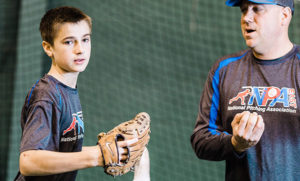
Many youth pitching coaches teach their players to ice their arms after a game. However, this might not actually help with healing and recovery. It’s a common misconception that ice can help pitchers heal faster or more effectively. However, research doesn’t really support this claim. So, let’s discuss why ice might not be a good idea for pitcher recovery and some things to try instead.
Why Many Players Start Icing their Arms In Youth Pitching
Pitchers that ice their arms after a game typically have been doing it since their youth pitching days. Likely, a coach told them that they needed to use the RICE method to help promote healing, so they’ve been saran wrapping an ice pack to their arm after games ever since. However, this is just another example of conventional wisdom versus science in pitching.
RICE stands for rest, ice, compression, and elevation. It was coined by Dr. Gabe Mirkin in 1978. It became incredibly popular for athlete recovery routines. You’ve probably heard of RICE at some point in your life. However, what many people don’t realize is that a lot of research suggests that RICE isn’t necessarily effective. In fact, in 2015 Dr. Mirkin himself debunked the use of rest and ice for recovery in his blog “Why Ice Delays Recovery.” Therefore, many athletes are using RICE when there isn’t a lot of evidence to back it up.
Icing Your Pitching Arm Can Delay Healing
Why might rest and ice interfere with recovery after pitching? To answer this question, it’s important to understand how healing works. After pitching in a baseball game, a player might experience mild muscle soreness in the pitching arm. This is typically caused by micro-tears in the muscle. These tears are actually how your body builds muscle, as the body repairs the muscles to be bigger and stronger. Healing begins with inflammation, which brings nutrients and healing cells to the area through increased blood flow. Ice can actually delay and reduce inflammation that is necessary for healing. While icing the arm can help reduce pain, research suggests it doesn’t speed up or improve recovery. Therefore, many pitchers have stopped icing their arms and opted instead for routines that help increase circulation and blood flow. For instance, our pitching lessons include a complete recovery program full of strategies for increasing blood flow.
Of course, it’s important to mention that in this article we’re talking about minor muscle soreness caused by micro-tears in the muscles, not injury-related pain or soreness. If a pitcher experiences pain or any other signs of injury, it’s important to stop immediately. Youth pitchers should talk to a coach or parent about potential injuries as soon as possible, as they may need to see a doctor for treatment.
Pitching Lessons for Players of All Skill Levels
Our pitching instruction at National Pitching is based on health-first, science-backed methodologies developed by Dr. Tom House, the father of modern pitching mechanics. We work with players of all ages and skill levels to provide pitchers with a toolkit for success. Our team makes good pitchers great through our comprehensive program that addresses everything from biomechanics and arm care to nutrition and mental management. Ready to get started? Find a pitching coach near you or purchase a V.I.P. membership for exclusive access to our library of instructional videos.
